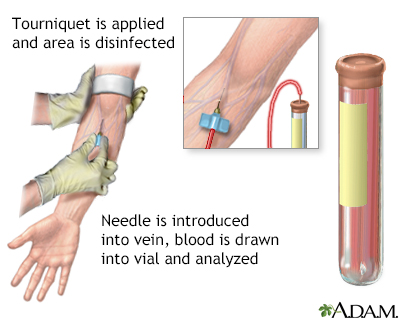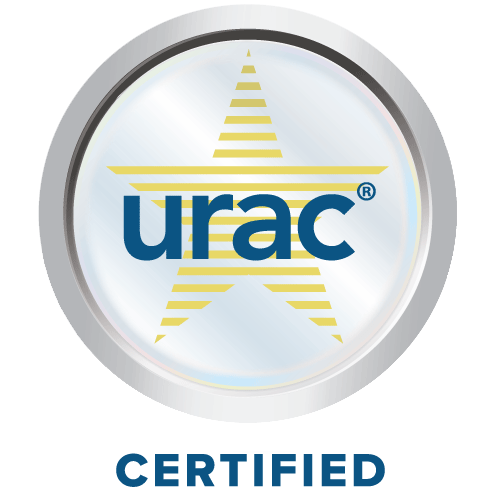Myoglobin blood test
Serum myoglobin; Heart attack - myoglobin blood test; Myositis - myoglobin blood test; Rhabdomyolysis - myoglobin blood test
The myoglobin blood test measures the level of the protein myoglobin in the blood.
Myoglobin can also be measured with a urine test.
Images

How the Test is Performed
A blood sample is needed.
How to Prepare for the Test
No special preparation is needed.
How the Test will Feel
When the needle is inserted to draw blood, some people feel moderate pain. Others feel only a prick or stinging. Afterward, there may be some throbbing or a slight bruise. This soon goes away.
Why the Test is Performed
Myoglobin is a protein in heart and skeletal muscles. When you exercise, your muscles use up available oxygen. Myoglobin has oxygen attached to it, which provides extra oxygen for the muscles to keep at a high level of activity for a longer period.
When muscle is damaged, myoglobin in muscle cells is released into the bloodstream. The kidneys help remove myoglobin from the blood into the urine. When the level of myoglobin is too high, it can damage the kidneys.
This test is ordered when your health care provider suspects you have muscle damage, most often of the skeletal muscles. It may also be ordered if you have acute kidney failure without any clear cause.
Normal Results
The normal range is 0 to 72 ng/mL (0 to 4.19 nmol/L) for males and 0 to 58 ng/mL (0 to 3.37 nmol/L) for females.
Note: Normal value ranges may vary slightly among different labs. Some labs use different measurements or may test different samples. Talk to your provider about the meaning of your specific test results.
What Abnormal Results Mean
An increased level of myoglobin may be due to:
- Heart attack
- Malignant hyperthermia (very rare)
- Disorder that causes muscle weakness and loss of muscle tissue (muscular dystrophy)
- Breakdown of muscle tissue that leads to the release of muscle fiber contents into the blood (rhabdomyolysis)
- Skeletal muscle myositis (inflammation)
- Skeletal muscle ischemia (oxygen deficiency)
- Skeletal muscle trauma
Risks
There is little risk involved with having your blood taken. Veins and arteries vary in size from one person to another, and from one side of the body to the other. Taking blood from some people may be more difficult than from others.
Other risks associated with having blood drawn are slight, but may include:
- Excessive bleeding
- Fainting or feeling lightheaded
- Multiple punctures to locate veins
- Hematoma (blood accumulating under the skin)
- Infection (a slight risk any time the skin is broken)
Related Information
Myoglobin urine testMyositis
Causes
Heart attack
Heart attack - test
Muscular dystrophy
Rhabdomyolysis
Malignant hyperthermia
References
Nagaraju K, Aggarwal R, Lundberg IE. Inflammatory diseases of muscle and other myopathies. In: Firestein GS, McInnes IB, Koretzky GA, Mikuls TR, Neogi T, O'Dell JR, eds. Firestein & Kelley's Textbook of Rheumatology. 12th ed. Philadelphia, PA: Elsevier; 2025:chap 86.
Selcen D. Muscle diseases. In: Goldman L, Cooney KA, eds. Goldman-Cecil Medicine. 27th ed. Philadelphia, PA: Elsevier; 2024:chap 389.
BACK TO TOPReview Date: 2/13/2025
Reviewed By: Jacob Berman, MD, MPH, Clinical Assistant Professor of Medicine, Division of General Internal Medicine, University of Washington School of Medicine, Seattle, WA. Also reviewed by David C. Dugdale, MD, Medical Director, Brenda Conaway, Editorial Director, and the A.D.A.M. Editorial team.

Health Content Provider
06/01/2028
|
A.D.A.M., Inc. is certified by URAC, for Health Content Provider (www.urac.org). URAC's certification program is an independent audit to verify that A.D.A.M. follows rigorous standards of quality and accountability. A.D.A.M. is among the first to achieve this important distinction for online health information and services. Learn more about A.D.A.M.'s editorial policy, editorial process and privacy policy. |
The information provided herein should not be used during any medical emergency or for the diagnosis or treatment of any medical condition. A licensed medical professional should be consulted for diagnosis and treatment of any and all medical conditions. Links to other sites are provided for information only -- they do not constitute endorsements of those other sites. © 1997- 2025 A.D.A.M., a business unit of Ebix, Inc. Any duplication or distribution of the information contained herein is strictly prohibited.
